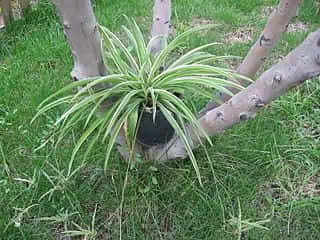The most favored houseplants are often those with striking features, elevating the room’s warmth. With that criterion alone, it’s hard not to include the spider plant, especially the variegated varieties.
A variegated spider plant has two different colors or shades in its foliage. The variegation is most likely a product of a long cross-breeding history between various spider plant species.
The most popular spider plants are variegated. Some have white to yellow streaks on the middle of the leaves and a dark green lining on the edge. Others have it the other way around.
Nonetheless, variegated spider plants continue to provide more varieties. Your options are so overwhelming that choosing the best one for your home is almost tricky.
But there’s nothing that information can’t help you with. So just read on and know more about variegated spider plants.
Table of Contents
What Is a Variegated Spider Plant?

Too get variegation in a spider plant or any plant is caused by a mutation of their original genetics which creates a new plant variety. There are sometimes that the original genes or strain can return.
With most spider plants, the foliage is an attractive combination of lighter-colored stripes located at the center or along the edges of the leaves and a green shade that goes parallel with the other hue.
The artistic mix of both colors often becomes the main attraction of the spider plant as far as aesthetics is concerned.
Since people tend to favor variegated spider plants over their non-variegated counterparts, horticulture experts began breeding more of these varieties to develop new ones.
Why Are Spider Plants Variegated?
Variegation in spider plants was deliberately incorporated through cross-breeding intra-specific varieties. Eventually, breeding became unnecessary as the variegated spider plants passed the coloration genes to their progeny.
Several factors were associated with spider plat variegation. One example is scientific curiosity. Experts were simply fascinated with the potential variety produced by combining two different spider plant varieties.
Eventually, the variegation became a beneficial tool for increasing the economic value of spider plants. In addition, people loved the striking appearance of the spider plant leaves.
As a result, it attracted the attention of interior designers, houseplant enthusiasts, and anyone who wishes to add some greenery inside their home.
Are All Spider Plants Variegated?

Not all spider plants are variegated. You can still find spider plants with a single color or shade.
Non-variegated spider plants often have solid green leaves. If this is the case, your spider plant probably has dominant unmutated genes.
Simply put, it exhibits the genetic qualities of the parent plant at its original state without the influence of cross-breeding.
Since most spider plants are variegated, finding a non-variegated version of the plant can be more difficult.
While some people would say that a pure green spider plant lacks the appeal of multi-colored variety, experts find the former more unique and interesting due to their rarity and healthier form.
Can a Spider Plant Lose its Variegation?
Yes, a spider plant can lose its variegation under certain conditions.
You may find your spider plant with diminishing green color or turning into pure solid green. These instances indicate threats to the spider plant’s health or survival.
For example, if your spider plant leaves begin to lose their green color, it could be due to intense sunlight. Bleaching often occurs when the leaves are exposed to excessive sunlight, causing sunburn and damage to the pigments of the foliage.
On the other hand, a variegated spider plant that has suddenly turned completely green could be a cry for more sunlight.
Spider plants can revert to their original non-variegated state under their survival mode.
The increase in green pigmentation allows the plant to photosynthesize more and produce more food. This process compensates for the limited solar energy the spider plant need to survive.
However, if the lack of sunlight persists, the spider plant could eventually wilt and die. So, if the leaves turn purely green, it’s best to put them in a place where they can get ample sunlight.
Popular Variegated Spider Plants to Have in Your Home
Looking for variegated spider plants has become easier considering their abundance in the market. But, most of the time, it all boils down to which variety to get.
If you’re set on getting a variegated spider plant, check out the four most popular varieties.
Class Variegated Spider Plant (Chlorophytum comosum Vittatum)
The variegated spider plant is the retro variety bearing the classic slightly arching slender, medium leaves with broad light stripes in the middle and green linings.
It is the most common spider plant considering it’s easy to grow indoors. Likewise, it stands 1 to 2 feet in width and length.
Reverse Variegated Spider Plant (Chlorophytum comosum Variegatum)

The reverse variegated spider plant is exactly what its name suggests. Its coloration is the opposite pattern of the regular variegated variety.
The leaves are also elongated with a broad green color that runs vertical with white to light yellow margins at the center.
A reverse variegated spider plant can grow up to 2 feet tall and 3 feet wide. Likewise, the leaves can reach up to 16 inches in length, relatively more extended than the variegated spider plant.
That’s why this variety is more common in the garden. However, many houseplant novices and enthusiasts remain keen on growing them indoors.
Variegated Curly Spider Plant (Chlorophytum comosum Bonnie Variegated)
Combining variegation with curls enhances the charms of a spider plant. Apparently, the same thought came into the minds of earlier cultivators. Thus, the bonnie or curly spider plant was born.
The curly spider plant looks like the classic variegated variety. Its leaves also have a broad white stripe in the middle and green edges. But, the variegated curly spider plant is more compact, brighter in color, and has well-bent arches.
The curly spider plant appears swirly and generally pleasant, providing additional charm to the room.
Zebra Spider Plant (Chlorophytum laxum)
The zebra spider plant is similar to the reverse variegated spider plant in color patterns. But instead of a refined outline, the zebra variety contains a brighter hue of white margins and lighter green in the middle.
As an indoor plant, the zebra spider plant is compact, but it mainly grows sideways than upwards. So, you will have to prune it regularly.
How To Take Care of a Variegated Spider Plant
One of the best attributes of variegated spider plants is that they are easy to care for.
Even an inexperienced plant enthusiast can grow the spider plant provided that the minimum requirements for nurture are met.
That being said, here are practical ways to take care of a variegated spider plant properly.
- Water the spider plant once a week during spring and summer. In the winter, keep the soil a little drier between watering intervals.
- Ensure the water is fluoride-free.
- Place the variegated spider plant where it can get bright to moderate light.
- Add fertilizer once a month.
Final Thoughts
It’s undeniable that variegated spider plants will remain in demand within the world of indoor plants.
They are easy to grow and lovely to look at. Plus, you can choose from equally appealing varieties.
Nonetheless, it’s best to learn the basic caring requirements for variegated spider plants. That way, you’re sure to get your money’s worth by keeping the plant thriving inside your home.
Recent Posts
Have you found yourself wondering, 'why is my bamboo growing so slow?' Despite the fact that bamboo plants are remarkably fast-growing, it can sometimes take months (or even years!) to see any signs...
Miracle-Gro is a huge help when you are trying to get decent yields out of your plants or if you want them to thrive. However, you may have noticed that a single dose of fertilizer does little to...

